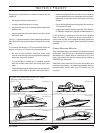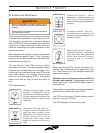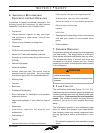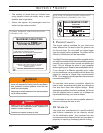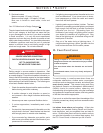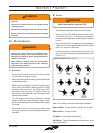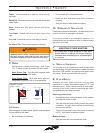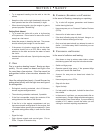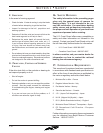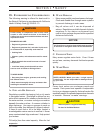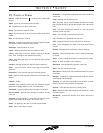
23 Outlaw
®
1.11
SeCtiOn 1 • SaFety
R
Speed changes you.
TM.
D. flooDinG, sWaMpinG anD capsizinG
In the event of ooding, swamping or capsizing:
• Try to shut off engines, generators and blowers
before leaving the boat.
• Have everyone put on Personal Flotation Devices
(PFDs).
• Account for all who were on board.
• If the boat is oating stay with the boat. Hang on, or
climb on the boat and signal for help.
• Only as a last resort should you attempt to swim to
shore - it is further away than it looks and you can
tire and drown.
e. collisions anD leakinG
In the event of collisions and leaking:
• Slow down or stop to reduce water intake, unless
maintaining speed will keep the hole above water.
• Switch on bilge pump.
• Operate manual bilge pump, if the powered bilge
pump can't handle the water ow.
• Account for everyone on board and check for
injuries.
• Have everyone put on PFDs.
• Stay with the boat.
• Signal for help.
• If a leak patch is attempted, it should be done from
the outside.
• In the event of a collision, you are required to le an
accident report. Contact a state enforcement agency
or the nearest Coast Guard ofce. If you are boating
outside of U.S. waters, consult the nation you are
visiting for accident reporting requirements.
• Try to approach heading into the wind or into the
waves.
• Keep the victim on the right (starboard) side so the
boat operator has the victim constantly in sight.
• When almost alongside, stop the engine in gear to
prevent propeller "windmilling."
Getting Back Aboard
• Try to reach the victim with a pole, or by throwing
a life preserver. Do not swim to rescue the victim,
except as a last resort.
• Assist the person in boarding the boat. The person
should normally be brought in over the stern.
• If the person is injured or cannot get into the boat,
a rescuer should put on a PFD with a safety line
attached to the boat and enter the water to assist
the victim.
• Handle the victim with care. Spinal injuries may have
occurred.
c. fire
Fire is a serious boating hazard. Boats can burn
quickly. Do not remain on board and ght a re
for more than a few minutes. If the re cannot be
extinguished within a few minutes, abandon the
boat.
Have re extinguishers handy. A small re can be
extinguished quickly with the right size and type of
re extinguisher.
• Extinguish smoking materials, shut off blowers,
stoves, engines and generators.
• Throw burning materials overboard, if possible.
• If the re is accessible, empty the contents of re
extinguishers at the base of the ames.
• If the re is in the engine compartment and you
have an automatic extinguisher for the engine, wait
15 minutes before opening the compartment. Have
a portable extinguisher ready in case the re ares
up.
• Signal for help.
• Grab distress signals and survival gear. Put on
PFDs. Prepare to abandon ship.



